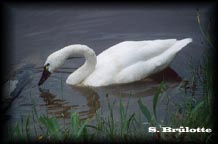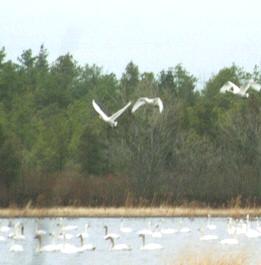

Tundra Swans like to eat the leaves, stems and tubers of aquatic plants that grow at shallow depths in fresh, brackish, or salt water. They reach this food by extending the head and neck downward, frequently tipping the body but seldom completely submerging. However, they will not turn down the occasional shellfish or mollusks, such as mussels and clams to vary their diet. They eat the stems, seeds, and bulbous roots of aquatic plants, and the seeds and young shoots of cultivated grains. They also eat a small amount of animal matter consisting mainly of the larvae of aquatic beetles and dragon flies, worms. In recent years, they have begun to feed extensively on grains, such as corn and wheat, that are left on the ground after the harvest.

The limnology (study of physical phenomena) of Long Point Bay is of the right make-up for staging as most of the waterways that lay beneath the Tundra Swan migration routes. These important stop-overs must provide the necessary fuel for flight. Tundra Swan food requirements are found in some of the following plants on route: foxtail (Alopecurus spp.) and other grasses, pondweeds (Potamogeton richardsonii), wild celery (Vallisneria americana), smartweeds, square-stem spike rush (Eleocharis quadrangulata), arrowhead (Sagittaria spp.), coontail (Ceratophyllum demersum), mermaid weed (Prosperinaca spp.), muskgrass, bulrushes, horsetail, wigeon grass (Ruppia maritima), and bur reed (Sparganium spp.). Rice and barley are eaten in stubble fields. Tundra swans also feed on waste corn in both dry and flooded fields and upon harvested potatoes. These swans commonly fly as far as 10 to 15 miles (16-24 km) inland to glean waste corn and soybeans and to browse upon shoots of winter wheat.
Feeding Research Project PDI 2.95.1 - 1995-1998:
Feeding behaviour of Cygnus columbianus and its influence on the population dynamics and structure of submerged macrophyte vegetation.
Feeding behaviour of Cygnus columbianus on plants, in particular Potamogeton pectinatus: food intake.
Research team Bart Nolet, Erik Wessel, Ten Dekkers, Koos Swart
Problem Definition:
Optimal foraging is a powerful tool to analyze the decisions of swan foraging on pondweed fields and to predict the effects of swans on the tuber density, depth distribution, and size. The basic currency of these models is energy. However, detailed knowledge about nutritional components other than energy may be required in order to explain the foraging behaviour of these herbivores.
Objectives:
Captive swans will be trained to forage in a basin and cages:
to study the swans' selection of water depths and prey size; to measure the functional response and energy gain curve; to test for the effect of the initial tuber density and intraspecific competition among swans on the giving-up density;
to measure the retention time and digestibility of the major food types (pondweed tubers, beets, grass); to test the outcome of cafetaria-tests against predictions from a linear programming model.
Achievements 1996:
The swan-pondweed interaction was studied in the field (Dvina Bay and Lake Lauwersmeer) in order to generate more specific hypotheses. A reconaissance trip was made to the Pechora Delta to investigate the possibilities to study this interaction at this important staging site as well. An experimental setup was built in Heteren (CTO) and six swans were caught and brought to this facility.
Planning 1997:
Experiments with captive swans foraging on pondweed tubers in a basin. (2) Measurements of retention time, digestibility and food preference of the major food types in captive swans.
Analysis with the object-oriented framework OSIRIS to explore whether the spatial distribution of swans can be understood on the basis of simple optimal foraging rules. Aerial counts of staging swans in the Dvina Bay (White Sea). Field measurements of swans feeding on tubers in the Pechora Delta.
©1998 The Wilderness Society, 900 Seventeenth Street NW, Washington, DC 20006-2596 www.wilderness.org

